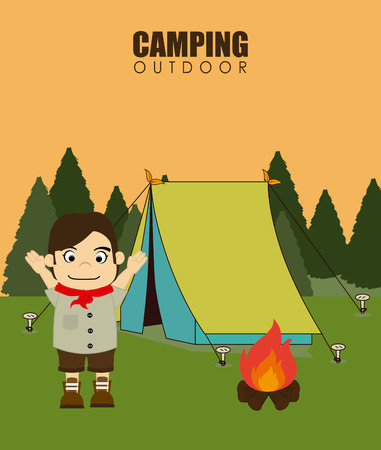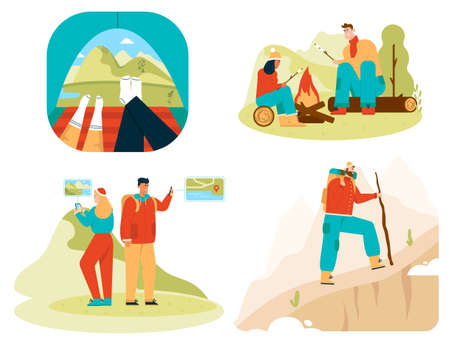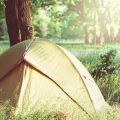1. Planning Your Rocky Mountain Camping Trip
Before heading into the breathtaking wilderness of the Rocky Mountains, its important to plan your camping trip carefully. From understanding the best times to visit to figuring out campsite reservations and permits, good planning can make all the difference in having a safe and memorable outdoor experience.
Best Time to Visit the Rockies
The Rocky Mountains offer different experiences depending on the season. Here’s a quick breakdown of what each season offers:
| Season | Weather Conditions | Pros | Cons |
|---|---|---|---|
| Spring (April – June) | Cool with snow in higher elevations | Fewer crowds, wildflowers blooming | Unpredictable weather, some roads/trails closed |
| Summer (July – August) | Warm days, cool nights | All trails open, great for hiking and families | Most crowded season, reservations needed early |
| Fall (September – October) | Crisp air, changing leaves | Stunning foliage, fewer bugs and people | Shorter days, cooler temps at night |
| Winter (November – March) | Snowy and cold | Skiing and snowshoeing opportunities | Difficult access, many campsites closed |
Choosing the Right Campsite
The Rockies cover a massive area that includes several national parks and forests. When picking a campsite, consider these factors:
- Accessibility: Are you driving in or hiking to your site?
- Amenities: Do you want toilets, fire rings, or picnic tables?
- Crowds: Popular areas like Rocky Mountain National Park fill up fast.
- Activities: Choose a location close to hiking trails, lakes, or scenic viewpoints.
- Elevation: Higher elevations are cooler and may still have snow in summer.
Popular Camping Areas in the Rockies:
| Campsite Area | Location | Main Features |
|---|---|---|
| Moraine Park Campground | Rocky Mountain National Park, CO | Easily accessible, great wildlife viewing |
| Twin Lakes Campground | Pike-San Isabel National Forests, CO | Lakeside views, boating access nearby |
| Bannock Pass Campgrounds | Bitterroot Range, MT/ID border | Remote setting with mountain vistas |
Permits and Reservations You Might Need
The rules for camping permits vary depending on where youre going. Heres what you need to know:
- National Parks: Most campgrounds in places like Rocky Mountain National Park require reservations through Recreation.gov. Backcountry camping usually needs a special permit.
- National Forests: Some campsites are first-come-first-served, while others allow advance booking. Dispersed camping is often free but requires following Leave No Trace principles.
- Wilderness Areas: These spots often require self-issued permits at trailheads or online registration for overnight stays.
Where to Make Reservations:
- Recreation.gov – For most federal campgrounds and backcountry permits.
- USDA Forest Service – For national forest sites and dispersed camping info.
- Colorado Parks & Wildlife – For state park campgrounds within Colorado.
The key to a stress-free trip is planning early—especially during peak summer months when campsites can book up months in advance. Keep these tips handy as you prepare for an unforgettable adventure in the Rockies!
2. Essential Gear for Mountain Camping
When youre camping in the Rockies, being prepared is everything. The weather can change quickly, and high altitudes bring their own challenges. Having the right gear isnt just about comfort—its about safety. Here’s a comprehensive checklist of what you’ll need to make your mountain adventure a success.
Tents and Shelter
Mountain weather can be unpredictable, so choosing the right tent is crucial. Look for a four-season or at least a sturdy three-season tent that can handle strong winds and sudden temperature drops.
- Four-season tent: Designed for high winds and snow
- Footprint: Protects the bottom of your tent from rough terrain
- Ground tarp: Extra moisture barrier
- Sturdy stakes and guylines: Keep your tent secure in windy conditions
Clothing Layers
Dressing in layers is key when camping at high elevations. Temperatures can vary widely between day and night, so you’ll want to be ready for anything.
| Layer | Description |
|---|---|
| Base Layer | Moisture-wicking material (like merino wool or synthetic fabrics) |
| Mid Layer | Insulating layer such as fleece or down jacket |
| Outer Layer | Waterproof and windproof shell jacket and pants |
| Accessories | Warm hat, gloves, neck gaiter, and thermal socks |
Cooking Equipment
You’ll need reliable cooking gear to prepare meals efficiently in the backcountry. At high altitudes, water takes longer to boil and fuel efficiency drops, so plan accordingly.
- Backpacking stove: Lightweight and fuel-efficient models are best
- Fuel canisters: Bring extra—cold temps can affect performance
- Cookware: Pots, pans, utensils (look for compact, nesting sets)
- Lighter & waterproof matches: Always have backups!
- Bear-proof food container: Required in many Rocky Mountain areas
- Biodegradable soap & sponge: For easy cleanup with minimal impact on nature
Safety Tools & Essentials
Your safety kit should always be within reach. In remote mountain terrain, help can be hours—or even days—away.
- First aid kit: Include altitude sickness meds if needed
- Navigation tools: Topo map, compass, GPS device or app with offline maps
- Headlamp with extra batteries: A must-have for early mornings or emergencies at night
- Multi-tool or knife: Useful for repairs or unexpected fixes
- Sunscreen & lip balm with SPF: UV exposure increases at higher elevations
- Trekking poles: Help with balance on steep trails and reduce strain on knees
- Emergency bivy sack or space blanket: Lightweight but potentially life-saving in cold conditions
Packing Tip:
A good rule of thumb is to pack light but never skimp on safety gear or warm clothing. In the Rockies, it’s better to overprepare than get caught off guard by a sudden storm or chilly night.
Your Rocky Mountain Camping Checklist Summary:
| Category | Must-Have Items |
|---|---|
| Shelter | Tent, footprint, tarp, stakes/guylines |
| Clothing Layers | Base layer, mid layer, outer layer, accessories (hat/gloves/socks) |
| Cooking Gear | Camp stove, fuel, cookware set, lighter/matches, bear canister, soap/sponge |
| Safety Tools | First aid kit, navigation tools, headlamp, multi-tool, sunscreen/SPF balm, trekking poles, emergency blanket/bivy sack |
Packing the right equipment will not only keep you safe but also let you enjoy the stunning beauty of the Rockies without worry.

3. Staying Safe in the Wilderness
Mountain camping in the Rockies is an unforgettable experience, but safety should always come first. The rugged terrain, unpredictable weather, and local wildlife can present real risks if youre not prepared. Here are some essential tips to help you stay safe while enjoying the great outdoors.
Wildlife Awareness
The Rockies are home to a wide range of wildlife including bears, mountain lions, elk, and moose. Knowing how to avoid unwanted encounters is key to keeping yourself and the animals safe.
Bear Safety Tips
- Store all food in bear-proof containers or hang it at least 10 feet off the ground and 4 feet from a tree trunk.
- Cook and eat away from your sleeping area—at least 100 yards if possible.
- Carry bear spray and know how to use it.
- Make noise on trails to avoid surprising animals.
Other Wildlife Tips
- Never feed wild animals—it’s dangerous for both you and them.
- Keep pets leashed and under control at all times.
- If you see a large animal like a moose or elk, give it plenty of space—especially during mating or calving seasons.
Preventing Altitude Sickness
The high elevations in the Rocky Mountains can lead to altitude sickness, especially if you’re coming from sea level. Symptoms include headache, nausea, dizziness, and fatigue. Heres how to prevent it:
| Tip | Description |
|---|---|
| Acclimate Slowly | If possible, spend a night at mid-altitude before heading higher. |
| Stay Hydrated | Drink more water than usual—dry mountain air can dehydrate you quickly. |
| Avoid Alcohol | Alcohol can worsen symptoms of altitude sickness and cause dehydration. |
| Pace Yourself | Avoid strenuous activity on your first day at high elevation. |
Fire Safety in the Backcountry
Campsite fires are cozy but can be dangerous if not handled responsibly. Wildfires are a serious concern in the Rockies, especially during dry seasons. Follow these fire safety tips:
- Check for local fire bans before starting any fire.
- Use designated fire rings whenever possible.
- Never leave a fire unattended, even for a minute.
- Douse your campfire completely with water before leaving—stir the ashes until they’re cold to the touch.
- If using a portable stove instead of an open flame, keep it on stable ground away from flammable materials.
Navigating Remote Mountain Terrain
The Rockies offer breathtaking views—but getting lost is easier than you might think. Cell service is often spotty or nonexistent, so its important to rely on tried-and-true navigation methods.
Navigation Essentials
- Bring a Topographic Map: Learn how to read it before your trip.
- Use a Compass or GPS Device: Don’t rely solely on phone apps without offline maps downloaded ahead of time.
- Mark Your Trail: Keep track of landmarks as you go; consider using trail markers or notes.
- Tell Someone Your Plan: Always let someone know where youre going and when you plan to return.
Staying safe in the wilderness requires preparation, awareness, and respect for nature. With the right knowledge and tools, you can fully enjoy everything that mountain camping in the Rockies has to offer—without unnecessary risk.
4. What to Eat: Campfire Cooking in the Rockies
One of the best parts of mountain camping in the Rockies is enjoying a warm, hearty meal after a long day of hiking and exploring. Whether youre cooking over an open fire or using a portable camp stove, having easy and satisfying food options can make your trip even more enjoyable. Here are some simple meal ideas that are perfect for the rugged mountain environment.
Trail Snacks to Keep You Going
When youre on the move, you’ll want quick and energy-packed snacks that don’t require cooking. These are great to keep in your backpack:
| Snack | Why It’s Great |
|---|---|
| Trail Mix | Customizable, high-energy mix of nuts, dried fruit, and chocolate or granola |
| Beef Jerky | Lightweight and packed with protein |
| Granola Bars | No prep needed and easy to pack |
| Dried Fruit | Naturally sweet and rich in fiber |
| Nut Butter Packets | Great for spreading on crackers or eating straight from the pouch |
Easy Campfire Breakfast Ideas
A good breakfast helps fuel your adventures. Try these simple options:
Campfire Breakfast Burritos
Scramble eggs with pre-cooked sausage or bacon, cheese, and peppers. Wrap it all in a tortilla and heat it over the fire or a pan. Wrap in foil for easy cleanup.
Oatmeal with Toppings
Boil water and add instant oats. Top with dried fruits, nuts, or brown sugar for a warm start to your morning.
Satisfying Lunch Options
Hiker’s Sandwiches
Use hearty bread like sourdough or ciabatta with deli meats, cheese, mustard, and pickles. They hold up well in your pack without getting soggy.
Couscous Salad
Couscous cooks quickly with just hot water. Mix with canned chickpeas, olive oil, lemon juice, and chopped veggies for a fresh midday meal.
Dinners Made Over the Fire
Tin Foil Packet Meals (Hobo Packs)
Chop potatoes, onions, carrots, and add protein like chicken or ground beef. Season well and wrap tightly in foil. Cook directly on hot coals for about 20–30 minutes.
One-Pot Chili
Using a cast iron pot or Dutch oven, combine canned beans, tomatoes, ground meat (or veggie crumbles), spices, and let simmer over the fire. Serve with crackers or cornbread if available.
Grilled Sausages & Veggies
Sausages cook quickly over an open flame. Pair with skewered bell peppers, mushrooms, and onions for an easy grilled dinner.
Sweet Campfire Treats
S’mores (Classic Must-Have)
You cant camp in the Rockies without making s’mores! All you need are graham crackers, marshmallows, and chocolate bars—roast your marshmallow to golden perfection over the fire.
Cinnamon Apple Foil Packs
Sliced apples mixed with cinnamon and sugar wrapped in foil make for a delicious dessert when cooked over coals for 10–15 minutes.
Packing Tips for Food in the Rockies
- Bear Safety: Always store food in bear-proof containers or hang it away from your campsite at night.
- No-Prep Meals: Pre-chop veggies and pre-cook proteins at home to save time at camp.
- Avoid Perishables: Unless you have a cooler with ice packs, stick to shelf-stable ingredients.
- Stay Hydrated: Bring extra water for cooking and drinking—mountain air can be dehydrating.
A little planning goes a long way when it comes to meals in the mountains. With these easy recipes and tips, youll be ready to eat well while enjoying everything the Rockies have to offer.
5. Leave No Trace and Eco-Friendly Camping
Mountain camping in the Rockies is an unforgettable experience, but its important to protect these pristine environments for future generations. Practicing Leave No Trace (LNT) principles and adopting eco-friendly habits can help minimize your impact on nature.
What Is Leave No Trace?
The Leave No Trace Center for Outdoor Ethics promotes seven core principles that guide responsible outdoor behavior. These principles are especially important in the fragile alpine ecosystems of the Rocky Mountains.
The 7 Leave No Trace Principles
| Principle | Description |
|---|---|
| 1. Plan Ahead and Prepare | Know the area youre visiting, check weather conditions, pack appropriate gear, and understand local regulations. |
| 2. Travel and Camp on Durable Surfaces | Use established trails and campsites to avoid damaging vegetation and soil. |
| 3. Dispose of Waste Properly | Pack out all trash, leftover food, and litter. Use established toilet facilities or pack out human waste when necessary. |
| 4. Leave What You Find | Do not pick plants, disturb wildlife, or remove natural objects like rocks or pinecones. |
| 5. Minimize Campfire Impact | Use a camp stove instead of building a fire, or follow local fire regulations if fires are allowed. |
| 6. Respect Wildlife | Observe animals from a distance and never feed them. Store food securely to avoid attracting bears or other wildlife. |
| 7. Be Considerate of Others | Keep noise levels down, yield to others on trails, and respect everyones outdoor experience. |
Sustainable Camping Tips for the Rockies
In addition to following LNT principles, here are some practical tips for eco-friendly camping in mountain environments:
- Use Reusable Gear: Bring reusable water bottles, utensils, and containers to reduce single-use plastics.
- Avoid Harmful Soaps: Use biodegradable soap at least 200 feet away from lakes or streams.
- Pack Light: Less gear means less waste and lower impact on trails and campsites.
- Select Low-Impact Campsites: Stay in designated areas whenever possible to protect native vegetation.
- Respect Fire Restrictions: Wildfires are a serious risk in the Rockies—always check current fire bans before lighting any flame.
Bears and Waste Management
The Rocky Mountains are home to black bears and grizzlies, so proper food storage is essential for both your safety and theirs. Here’s a quick guide:
| Item | Storage Method |
|---|---|
| Food & Snacks | Bear-proof containers or hang in bear bag at least 10 ft off ground & 4 ft from tree trunk |
| Toiletries (toothpaste, lotion) | Treat like food—store in bear-proof container or bag |
| Trash & Food Wrappers | Packed out daily in odor-proof bags or bear-resistant canisters |
Your Role as a Steward of the Rockies
The best way to enjoy the Rockies is by leaving them just as beautiful as you found them—or better. By embracing Leave No Trace values and practicing sustainable habits, youre helping preserve this incredible landscape for everyone who comes after you.


